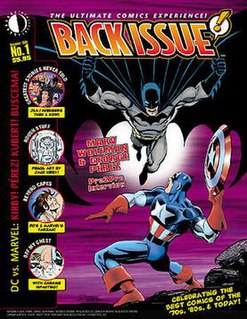 W
WAlter Ego is an American magazine devoted to comic books and comic-book creators of the 1930s to late-1960s periods comprising what fans and historians call the Golden Age and Silver Age of Comic Books.
 W
WThe Amazing World of DC Comics was DC Comics' self-produced fan magazine of the mid-1970s. Running 17 issues, the fanzine featured DC characters and their creators, and was exclusively available through mail order. Primarily text articles, with occasional strips and comics features, Amazing World offered a great deal of insight into Bronze Age DC corporate and creative culture.
 W
WBack Issue! is an American magazine published by TwoMorrows Publishing, based in Raleigh, North Carolina. Founded in 2003 and published eight times yearly, it features articles and art about comic books from the 1970s to the present.
 W
WThe Charton Bullseye was a fanzine published from 1975-76 by the CPL Gang highlighting Charlton Comics. It was a large format publication, with color covers on card stock and black & white interiors. Charton Bullseye published several previously unpublished Charlton superhero and adventure stories, along with articles on Charlton comics, news, reviews, pinups, and more.
 W
WThe Comic Reader (TCR) was a comics news-fanzine published from 1961 to 1984. Debuting in the pre-direct market era, TCR was the first regularly published comics industry news fanzine, and was able to secure many contacts from within the ranks of the larger publishers. As TCR increased in popularity and influence, it was able to attract professional artist to illustrate the covers. TCR also proved to be a launching pad for aspiring comic book creators, many of whom published work in the fanzine as amateurs. Contributors from the world of fandom included founding editor Jerry Bails, key editor Paul Levitz, Paul Kupperberg, Tony Isabella, Byron Preiss, Neal Pozner, Don Rosa, Carl Gafford, and Doug Hazlewood.
 W
WFOOM was Marvel Comics' self-produced fan magazine of the mid-1970s, following the canceled Marvelmania and preceding Marvel Age. Running 22 quarterly issues, it was initially designed and edited by celebrated comic book writer-artist Jim Steranko.
 W
WThe Imp is a zine about comics that was written and published by Daniel Raeburn during the late 1990s and early 2000s. Each issue of the zine examined a single cartoonist or type of comic in depth, often incorporating interviews done by Raeburn with or about the subject. Raeburn frequently took an idiosyncratic view of his subject matter in The Imp; in the introduction to the first issue he wrote that "the fact that I don't know anything about comics can only help me to take them seriously." He frequently described his personal experiences with his subject matter in irreverent terms and gave detailed accounts of the people and places he encountered while doing his research, in the manner of gonzo journalism. The Imp is also notable for the unique design of each issue.
 W
WMarvelmania International was comic-book publisher Marvel Comics' authorized but independently operated fan club from 1969 to 1971, which absorbed the Merry Marvel Marching Society begun in 1964. It included a six-issue fan magazine, Marvelmania Magazine.
 W
WPORK was a music magazine/fanzine created by husband and wife artist team Sean Aaberg and Katie Aaberg in 2010. PORK magazine has been a big catalyst for Weirdo Art and Rock&Roll, with an emphasis on street culture elements like denim, studs, pizza, burgers, switchblades and anti-social behavior. Its roots are in 70s New York City. It was a free magazine and in circulation between 2010 and 2018.
 W
WRocket's Blast Comicollector (RBCC) was a comics advertising fanzine published from 1964 to 1983. The result of a merger with a similar publication, RBCC's purpose was to bring fans together for the purpose of adding to their comic book collections. It also proved to be a launching pad for aspiring comic book creators, many of whom corresponded and exchanged their work through RBCC, and published work in the fanzine as amateurs.